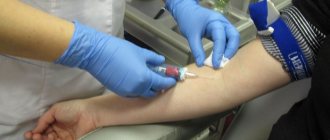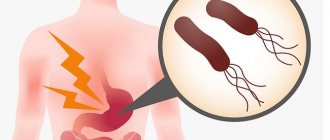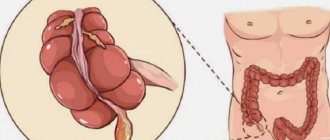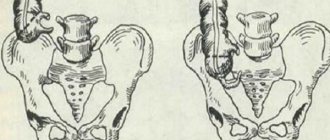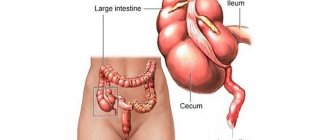Definition
Appendicitis is an inflammatory process occurring in the appendix of the cecum (appendix). Patients with this diagnosis make up a significant proportion of patients in surgical departments. Newborns and children suffer from this disease very rarely. This is due to the structural features of their body.
The disease tends to develop rapidly, which without immediate surgical intervention can lead to life-threatening complications. Appendicitis is also dangerous because in some cases the symptoms are quite vague, which makes it difficult to diagnose. To confirm the diagnosis, a set of emergency measures is used, not least of which is a blood test.
Indications for analysis
Appendicitis can be indicated by a large number of symptoms, and if they occur, you should consult a doctor. These include:
- A steady increase in temperature over several days.
- Loss of appetite.
- Weakness, fatigue.
- Nausea and vomiting.
- Painful urination.
- Cramps.
- Diarrhea.
- Sharp and nagging pain on the right side of the abdomen.
In some cases, the clinical picture is quite clear, which makes it easy to diagnose the disease. But with vague symptoms, additional examination methods are needed to confirm the development of the pathological process. In children, determining the presence of appendicitis is much more difficult, because they cannot always correctly indicate the source of the ailment. Therefore, if there is an unexplained change in behavior, increased irritability and pain, which disappears or significantly decreases when the body is positioned on the right side, it is necessary to consult a doctor as soon as possible.
Symptoms of appendicitis
The first symptomatic signs of an inflamed appendix are:
- nausea;
- vomiting;
- prolonged severe pain in the right side of the abdomen;
- increased spasms during palpation of the area of the vermiform appendage of the cecum, physical exercise, changes in body position;
- stool irregularity;
- decreased appetite;
- weakness;
- increased body temperature;
- cardiopalmus;
- tearfulness in young children.
With inflammation of the appendix of the cecum, only some symptomatic signs may be observed for 6-8 hours. In older people, in accordance with age characteristics, appendicitis does not have pronounced manifestations. The main symptoms of the pathology in young children are diarrhea, vomiting, tearfulness, and lack of appetite.
Rules for taking blood
The procedure for collecting blood for appendicitis can be performed in two ways:
- Taking blood from a finger. Capillary blood is used for the study.
- Taking blood from a vein. In this case, venous blood is used. This method allows for immediate biochemical analysis.
To obtain the most reliable result, you must adhere to a number of rules (with the exception of emergency cases):
- Blood sampling is done on an empty stomach.
- A few days before the analysis, avoid fatty, smoked, fried foods and alcohol.
- Do not smoke several hours before the procedure.
- Do not take medications for about a day. If it is impossible to cancel the drugs, you must notify the laboratory technician.
Blood test for appendicitis
To confirm the diagnosis, a set of diagnostic measures is used, an important place among which is a blood test. When deciphering the results, the values of the following indicators are especially important:
- Leukocytes. Immune cells that detect abnormal cells in the blood, then attack and eliminate them.
- Erythrocyte sedimentation rate (ESR). An important indicator that indicates the intensity of the disease.
- Red blood cells.
- Band neutrophils. They are a type of leukocyte. But in addition to the protective function, they restore damaged tissues.
- S-RB. When an inflammatory focus develops, the liver synthesizes a specific protein that suppresses the development of infection.
- HCG.
Decoding
When deciphering a general blood test for appendicitis, some features must be taken into account. For example:
- Patient's age.
- Presence of chronic diseases.
- General condition of the body at the time of blood donation.
- Pregnancy.
It must be remembered that during pregnancy the leukocyte count and erythrocyte sedimentation rate are slightly higher than normal values. But at the same time, this condition is not considered pathological if no additional symptoms occur. In this case, it is recommended to use other diagnostic methods.
In older people, the leukocyte count may not reveal a pathological increase in leukocytes due to the age characteristics of the patient.
An hCG test is prescribed to exclude ectopic pregnancy, the symptoms of which can easily be confused with the development of appendicitis. In this case, elevated white blood cells will be found not only in the blood, but also in the urine.
Diagnostic methods
For inflammation of the appendix, the main diagnostic methods are prescribed:
- primary examination - palpation;
- lab tests:
- blood;
- urine;
- instrumental research:
- computer, magnetic resonance imaging;
- ultrasound examination of the abdominal organs;
- medical thermography;
- laparoscopy;
- radiography.
Diagnostics allows you to detect the disease in a timely manner, prescribe effective treatment, and eliminate the pathology.
Initial examination
The first diagnostic method is an initial examination with palpation of the abdominal area. If the blood supply to the appendix is disrupted, strong, sharp pain is observed when pressing on the iliac region on the right side. In some clinical cases, the doctor may feel the inflamed appendix. The basic rule of palpation is to sharply release the hands after pressing on the abdomen. A description of associated symptomatic signs is an important part of the purpose of additional studies.
Lab tests
Submitting biological material for laboratory testing is important to determine further treatment for appendicitis. The exception is clinical cases when there is a serious complication that requires immediate surgical intervention to avoid the death of the patient. Based on the results of laboratory tests of blood and urine, it is possible to determine the cause of inflammation and eliminate possible problems with urination.
Biological material is collected to carry out the necessary tests:
- general blood and urine analysis if appendicitis is suspected;
- measuring the level of red blood cells, leukocytes;
- establishing the reactive protein indicator;
- determination of hCG level.
Establishing the number of leukocytes and erythrocytes contained in the blood allows us to identify the internal inflammatory process. Urine examination makes it possible to exclude diseases of the urinary system and determine the presence of pathogenic bacteria, infections, and viruses.
An increase in the number of leukocytes and red blood cells indicates the effect of an inflamed appendix on the urinary system. An indirect sign of damage to the vermiform appendage of the cecum is intense, dark color of urine.
Required parameters
The main indicator in laboratory analysis is the level of leukocytes in the blood. It indicates the presence of an internal inflammatory process and the nature of the pathology. Leukocytes in appendicitis have an indicator of 11-15 units in children, more than 18 in adults. High indices are grounds for emergency hospitalization and surgery. The predominance of the neutrophilic variety of leukocytes indicates that the inflammation becomes acute. Each person’s blood circulation is individual, therefore, to avoid inaccuracies, biological material is collected several times throughout the day.
Tests to determine inflammation of appendicitis involve determining the erythrocyte sedimentation rate. An increase in the indicator indicates an exacerbation of the pathology. Changes in hormonal balance during pregnancy in women are the cause of an unstable erythrocyte sedimentation rate index, as well as a possible slight increase in the level of white blood cells.
Signs of the inflammatory process are directly related to the level of reactive protein. Therefore, this indicator is not an infallible method for determining appendicitis, as it indicates a change in the functioning of any body system. For women, a blood test is required to determine the level of human chorionic gonadotropin (hCG) to distinguish appendicitis from signs of ectopic pregnancy. The accuracy of the result is ensured by the regularity and dynamism of the procedure.
Blood counts in adults
A blood test for appendicitis in adults primarily reveals the level of white blood cells. At an early stage of the disease, this indicator will be within the normal range or slightly increased. In this case, the patient is sent to the hospital for observation and after some time the analysis is repeated.
A few hours after the first signs appear, the level of white blood cells will begin to gradually rise. At a severe stage of the disease and without treatment, a 2-fold increase in the content of white blood cells may be observed. This is a very dangerous condition, which indicates the development of acute inflammation in the body, which could occur in the event of a ruptured appendix and the development of peritonitis. In this situation, emergency surgery is necessary.
Sometimes a normal white blood cell count is diagnosed, but symptoms typical of appendicitis are observed. This is an indication for additional diagnostic measures and is not considered a contraindication for surgery.
| Normal, 109/l | The presence of an inflammatory process | Possibility of peritonitis |
| 4,0–9,0 | 12,0–14,0 | 19,0–20,0 |
How is acute appendicitis diagnosed?
The development of acute inflammation in the appendix can be suspected based on the clinical picture characteristic of this disease. The onset of inflammation is characterized by the appearance of painful sensations in the upper abdominal cavity, which, with the typical location of the appendix, descend to the right iliac region after a few hours. In addition to pain, a sick person may experience nausea, general weakness, and dyspeptic disorders. With catarrhal changes, there are no symptoms of severe intoxication, that is, pulse and body temperature remain within normal limits. Subsequently, the catarrhal phase turns into destructive forms of appendicitis, in which case vomiting may occur, the pulse increases, and the temperature rises to 38 degrees or higher.
The symptoms listed above should already cause the doctor examining the patient to assume the development of appendicitis. To confirm and exclude this diagnosis, a number of examinations are prescribed, the most mandatory of which include blood and urine tests. If possible, the patient undergoes an ultrasound of the abdominal organs, and, if necessary, radiography and computed tomography to exclude other pathologies. In addition to instrumental examinations, the patient, in addition to the attending surgeon, should be examined by other specialists - a therapist, a gastroenterologist. Women with an acute abdomen must be examined by a gynecologist to exclude ectopic pregnancy and acute adnexitis.
A presumptive diagnosis of appendicitis is made only with a cumulative assessment of all examinations, examinations and test data. And even if the diagnosis is in doubt, but most of the data suggests an acute pathology in the abdomen, then surgical intervention is prescribed. During the operation, the pathology is determined and a decision is made on further tactics for managing the patient.
ESR index
The erythrocyte sedimentation rate is a fairly informative indicator in the development of inflammatory processes in the body. In its normal state it is stable. But if a blood test for appendicitis reveals an increase in ESR, especially against the background of an increase in the content of leukocytes, this is a sign of the development of an acute inflammatory process occurring in the body.
Below is a table of ESR values (mm/h).
| Teenage children | Women | Men |
| 3–12 | 2–15 | 8–15 |
What does leukocytosis indicate in acute appendicitis?
The norm of leukocytes in the blood for an adult is 4.0–9.0 × 10 9 per liter. Leukocytosis, that is, an increase in the number of leukocytes, indicates an inflammatory process in the body. With appendicitis, changes in the blood test will depend on the stage of inflammation at which the examination is carried out:
- In the catarrhal form of appendicitis, which can last up to two days, there may be no leukocytosis or it will be completely insignificant. The absence of changes in the tests is usually observed in the first hours of the development of the pathology, so it is important to repeat the tests several times after the patient is admitted to the hospital and if the diagnosis is questionable. Increasing leukocytosis with a shift in the leukocyte formula to the left, together with the characteristic symptoms of inflammation of the appendix, makes it more likely to correctly diagnose.
- In destructive forms of inflammation, that is, when pus forms in the appendix and areas of dead tissue appear, leukocytosis can reach 18 or higher. As the number of leukocytes increases, the patient’s pulse also increases; with extensive inflammation, it can reach up to 120 beats per minute. With such indicators and the clinical picture of an acute abdomen, a treatment regimen should be determined as quickly as possible. Usually in such situations, surgery is prescribed, which is carried out against the background of antibiotic therapy.
- An increase in the number of leukocytes to 20 or higher may indicate complications of the disease. Perforation of the walls of the appendix leads to the release of purulent contents into the abdominal cavity, where, under the influence of infection, all organs are included in the inflammatory process.
It is necessary to understand that with appendicitis, a large number of leukocytes will not always be observed in blood tests. There may be no leukocytosis in elderly patients or in the first hours of illness. When examining older people with suspected appendicitis, the peculiarities of the course of the disease during this period of life are always taken into account. In old age, in addition to the absence of an increased number of leukocytes in the blood, there may be no characteristic pain in its manifestations.
When examining pregnant women for possible inflammation of the appendix, one must take into account the fact that during this period, expectant mothers are almost always diagnosed with leukocytosis. Normal levels during pregnancy are considered to be 8.0-12.0 x10 9 /l. That is, with appendicitis in pregnant women, it should be said when leukocytes in the blood are detected above 12.
Features of analysis in children
The development of appendicitis in children occurs in a more dangerous form. This is due to the immaturity of the immune system. Diagnosis can be difficult, since the child cannot always explain the source of pain. But when examining painful areas, children begin to cry and push away the doctor’s hand.
Despite the similarity of diagnostic measures, a blood test for appendicitis in children and adults will be slightly different, since the norms for some indicators differ.
Below is a table of leukocyte levels within normal limits in children of different ages (109/l).
| 0-3 years | 3–6 years | After 11 years |
| 6–17 | 5–12 | 9–12 |
In acute appendicitis, a blood test will indicate a sharp rise in ESR levels against the background of an increase in white blood cells and C-reactive protein.
Leukocytosis in complications of appendicitis
With the catarrhal form of appendicitis and initial destructive changes, leukocytosis is most often moderate, in the range of 12-14 x10 9 /l. If during this period there is no adequate treatment of the disease, that is, surgery, then in most cases complications develop. The most common of these is perforation of the organ and release of purulent mass into the abdominal cavity. Perforation with subsequent development of peritonitis can also be determined by the clinical picture of the disease and according to instrumental examinations.
- Peritonitis is characterized by pain throughout the abdomen, noticeable bloating, lack of stool, and general symptoms of intoxication. As this complication develops, the pulse becomes thread-like and frequent, and can reach up to 140 beats per minute. If you do a blood test at this time, it will reveal pronounced leukocytosis, increased compared to the norm of ESR. If leukopenia is detected, that is, a decrease in the number of leukocytes in the peripheral blood, then this indicates a severe pathology.
- Moderate leukocytosis can also occur in humans with the development of appendiceal infiltrate. This term refers to a condition in which inflammation from the appendix spreads to the intestinal organs and a welded conglomerate is formed. In addition to an increase in the number of leukocytes, this complication reveals a shift in neutrophils. A patient with appendiceal infiltrate is treated in the first weeks without surgery; he is prescribed antibacterial therapy, under the influence of which the inflammation is relieved and blood tests return to normal.
- Appendiceal abscesses develop 8-12 days from the onset of the disease. Ulcers can be located anywhere in the abdominal cavity. This complication can be suspected by a deterioration in the patient’s general well-being, an increase in temperature, chills, and an increase in pulse. Leukocytosis increases in the blood, and a shift to the left of the leukocyte formula is determined.
- Pylephlebitis is one of the most serious complications of appendicitis. This term refers to purulent thrombophlebitis of the portal vein of the liver. The general condition of the patient is very serious, the most constant symptom is stunning chills, rapid pulse and temperature up to 40 degrees. There is high leukocytosis and ESR in the blood.
When making a diagnosis of appendicitis and identifying its complications, all blood parameters are taken into account, they are carried out repeatedly throughout the day, identifying all changes. The decision to choose a treatment method is made taking into account the patient’s condition. In case of complications, the outcome of treatment largely depends on the patient’s age, time of admission to the hospital, and concomitant pathologies. With appendicitis, even now, deaths often occur, and they often occur due to the patient’s late presentation to a medical facility.
Additional diagnostics and treatment
Only a doctor can determine which blood test for appendicitis will be most accurate. But due to the fact that this analysis may provide inaccurate information, additional diagnostic measures are necessary. These include:
- Analysis of urine. It is a fairly informative diagnostic method. The development of appendicitis will be indicated by the presence of leukocytes, protein and bacteria. But if the presence of red blood cells in the urine is detected, it is highly likely that one can judge the development of diseases of the genitourinary system and kidneys.
- Computed tomography, which is used when an abscess is suspected.
- Laparoscopy. This is a modern and effective method of diagnosis and treatment, which practically does not cause complications. Once the diagnosis is confirmed, surgery to remove it is immediately performed.
Until the results of the prescribed tests are received and the diagnosis is confirmed, surgical intervention is performed extremely rarely. A qualified surgeon assesses the clinical picture of the disease and interprets the data obtained.
In the treatment of appendicitis, medications are used as symptomatic therapy, but the underlying pathology can only be treated surgically.
Complications
Appendicitis is a very dangerous disease, especially for children in whom it develops more rapidly. Delayed treatment or lack thereof can lead to life-threatening complications. These include:
- Rupture of the appendix.
- Sepsis.
- Peritonitis.
- Isolated purulent focus.
- Perforation of the process.
With appendicitis, the inflammatory process develops very quickly, provoking serious pathological conditions. If signs of an acute form of the disease appear, emergency surgery is necessary.
